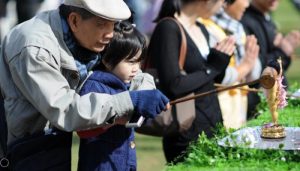
François-Léon Benouville (1842).
[Wikimedia/Columbus Art Museum (CC BY-SA 4.0)]
One of this week’s lectionary readings (Fifth Sunday in Lent) is the passage in the Gospel of John about one of the Mary’s anointing Jesus’ feet (John 12:1-8). Anointing, in a general sense, is about Divine suffusion. It’s about recognizing that something, someone, or some situation is both special and a vessel for the Sacred. It’s about honoring the Holy. It’s about showering with blessings.
Given all that, it’s no wonder that the act of “anointing” predates written history and shows up in different faith traditions. And it’s not just about oil. Blood, fat, milk and butter are also popular anointing fluids. Here’s a brief rundown.
Judaism
The anointings of Saul (1 Samuel 9:27-10:1a) and David (1 Samuel 16: 1-13) are among the most notable in the Jewish Bible/Tanakh. But Moses also anointed Aaron and his sons when they were ordained as high priests (Leviticus, chapter 8). It was an incredibly elaborate ceremony that involved a fair amount of oil, fat, and blood. It’s worth a re-read if you haven’t looked at it in a while. And lest you think the Bible is only about the anointing of people, Moses also anointed the meeting tent and the ark of the covenant with oil (Exodus 30:22-29).
Eastern Orthodox/Catholic
The Catholic and Eastern Orthodox traditions have really leaned into the oil idea. In some churches, the baptism ritual makes use of chrism, which is supposed to contain a small portion of oil that was blessed by the original Twelve Apostles. Confirmation rituals, the anointing of the sick, and the ordination of priests also frequently use oil. And don’t forget about the objects. Up until the Second Vatican Council, chalices were anointed with chrism before being used.

[from Vrindabanbehari.com]
Indian Traditions [including Sanatana Dharma (aka Hinduism), Jainism, and some Buddhism]
Anointing has been around “forever” in the cultures of South and Southeast Asia. Frequently, some product made from the holy cow (e.g., butter, milk, ghee), is used instead of oil, but honey, flower-scented/herbal-infused water, and tea can all work, too.
Since those traditions tend to recognize the Divine Presence in many things, one is encouraged to anoint freely! Deity statues, people, or other objects are all good places to start. A new home is anointed before moving in, and the sick are anointed as they die. Milk might be poured over the head of a baby Buddha statue to honor his birth, coconut water might be poured over the head of Krishna to promote family wellness, and yogurt might be used to install a new deity in a sacred space.
The Buddha even talked about anointing one’s parents as a sign of veneration.

Mother and father are called “Brahma,” “early teachers,” and “worthy of veneration,” being compassionate towards their family of children.
Thus the wise should venerate them, pay them due honor, provide them with food and drink, give them clothing and a bed, anoint and bathe them, and also wash their feet.
When he performs such service for his mother and his father, they praise that wise person even here, and hereafter he rejoices in heaven.
Itivuttaka: Group of Fours (Access to Insight)
In the Christian tradition, anointing generally marks someone as being special in the eyes of God. But the idea of anointing to indicate “specialness” has been around for a very long time, which makes “anointing” a human practice, rather than a religious-specific practice. And that means it’s a good topic for breaking down traditional religious barriers.
Multifaith Mashup provides passages from the writings/sacred texts of other faith traditions that match an excerpt from the Biblical lections offered in the Revised Common Lectionary. Sign up for our blog to receive regular posts. Questions? Contact us at vicki@worldreligions4kids.com.